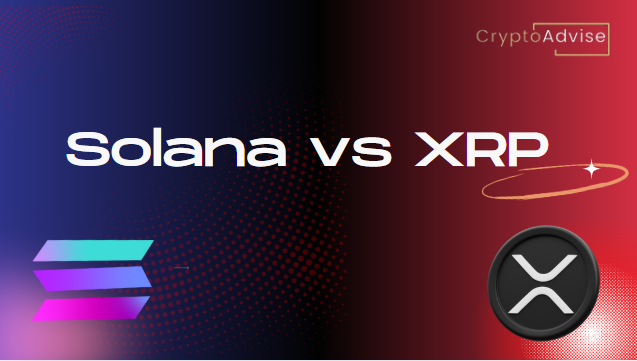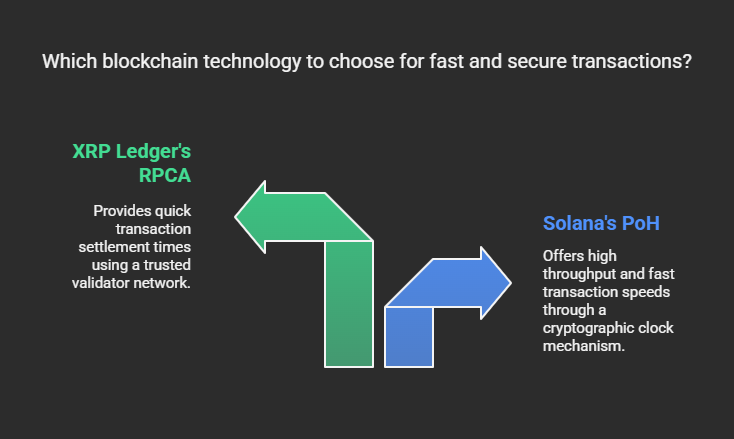Solana vs Ripple: The Ultimate Showdown of Real-World Utility & Future Potential
Introduction: Which Blockchain Reigns Supreme?
When it comes to altcoins, Solana vs Ripple (XRP) debate has been evergreen that who will dominate discussions in the crypto space. Both projects prioritize speed, scalability, and efficiency, but their core objectives and target audiences set them apart.
Solana is built for Web3—powering decentralized applications (DApps), smart contracts, NFTs, and gaming—while Ripple is laser-focused on streamlining global banking and cross-border payments for financial institutions.

So, which blockchain is better? Which one has a stronger future? Let’s break it all down in this in-depth battle between Solana and Ripple.
What is Solana? The Ethereum Killer or Just Hype?
Solana is a high-speed blockchain platform known for its blazing transaction speeds and minimal fees. Created in 2017 by Anatoly Yakovenko and Raj Gokal, it launched its mainnet beta in 2020, quickly establishing itself as a serious competitor to Ethereum.
Key Features That Make Solana Stand Out
- Mind-blowing speed: Solana processes over 65,000 transactions per second (TPS), making it one of the fastest blockchains ever.
- Near-zero fees: Transactions cost just fractions of a cent, making it highly cost-effective for users and developers.
- Proof-of-History (PoH): This innovative consensus mechanism timestamps transactions before they’re processed, eliminating network congestion.
- Smart contracts and Web3 apps: Solana is home to NFTs, DeFi platforms, and blockchain-based games, positioning itself as a Web3 powerhouse.

Solana’s Growing Ecosystem
The blockchain is expanding rapidly across various sectors:
DeFi Dominance
Platforms like Raydium, Serum, and Solend are thriving on Solana, offering fast and cheap decentralized trading, lending, and liquidity services.
NFT & Creator Boom
Solana has gained traction in the NFT space, hosting popular marketplaces like Magic Eden while attracting artists and developers seeking a low-cost alternative to Ethereum.
Blockchain Gaming Revolution
Games like Star Atlas and Aurory are redefining gaming by integrating NFT ownership, play-to-earn models, and decentralized economies powered by Solana.
However, not everything is perfect. Solana has faced frequent network congestion and memecoin explosions—notably, the LIBRA incident of February 2025, where a meme coin promoted by Argentine President Javier Milei skyrocketed before crashing, leading to significant investor losses. This raised concerns about network security and reliability for serious investors.
What is Ripple? The Future of Cross-Border Payments?
Unlike Solana, Ripple is not a smart contract platform. Instead, it’s a financial technology company utilizing the XRP Ledger (XRPL) and its native token, XRP, to revolutionize global finance.
🏦 Why Banks & Institutions Love Ripple
Ripple is built for efficiency in finance, and its primary use cases include:
- Lightning-fast international payments – Settles transactions in 3-5 seconds.
- On-Demand Liquidity (ODL) – Eliminates the need for pre-funded foreign currency accounts, making cross-border transactions cheaper.
- Central Bank Digital Currencies (CBDCs) – Ripple partners with governments to integrate XRP-based financial systems for global adoption.

🔍 XRP Ledger’s Game-Changing Technology
Unlike Solana, which uses PoH and PoS, the XRP Ledger relies on a unique consensus mechanism called the Ripple Protocol Consensus Algorithm (RPCA):
- Transactions are validated by trusted nodes rather than traditional mining or staking.
- The system avoids energy-intensive mining, making it greener and more efficient.
- With 80% validator approval, transactions are confirmed instantly.
This makes XRP ideal for financial institutions, banks, and payment processors, rather than DApps or NFTs like Solana.
Ripple’s SEC Lawsuit: What You Need to Know
Ripple has been in a legal battle with the SEC since December 2020, accused of conducting an unregistered securities offering by selling XRP. This lawsuit has restricted XRP’s growth in the U.S., leading to volatility and uncertainty among investors.
Despite this, Ripple has scored legal victories and secured major partnerships worldwide, including regulatory approval for RLUSD, Ripple’s stablecoin, in December 2024. A crypto-friendly U.S. administration elected in 2024 has also boosted optimism about a favorable resolution to Ripple’s legal woes.
🛠️ Battle of Technologies: Solana vs Ripple
Feature | Solana (SOL) | Ripple (XRP) |
|---|---|---|
| Speed | 65,000+ TPS | 1,500 TPS (but settles in 3-5 secs) |
| Transaction Cost | Near zero | Extremely low |
| Consensus Mechanism | PoH + PoS | Ripple Protocol Consensus Algorithm |
| Main Use Case | Web3, DeFi, NFTs, Gaming | Cross-border payments, banking solutions |
| Institutional Adoption | Growing but still new | Strong institutional presence |
Solana’s Proof-of-History (PoH)
Solana’s PoH functions like a cryptographic clock, creating a verifiable sequence of timestamps to order transactions efficiently. This innovation minimizes communication between validators, reducing latency and allowing for extremely high throughput.
By integrating PoH with PoS, Solana achieves lightning-fast transaction speeds while maintaining network security.

XRP Ledger’s Consensus Algorithm
The XRPL employs the Ripple Protocol Consensus Algorithm (RPCA), which relies on a network of trusted validators to confirm transactions. Instead of mining, validators agree on the validity of transactions in real time, reaching consensus with an 80% approval threshold.
As a result, transactions on the XRPL are settled within three to five seconds, making it ideal for financial settlements.
Future Prospects: Where Are They Headed?

📈 Solana’s Roadmap for 2025 and Beyond
Solana’s future looks promising, with massive growth expected in:
- DeFi and Web3 adoption – More developers are choosing Solana over Ethereum for its scalability and low fees.
- Real-time multiplayer gaming – The integration of blockchain and gaming is expected to skyrocket.
- Enterprise blockchain solutions – Solana’s speed makes it attractive for supply chain management, AI-powered automation, and data processing.
Price Prediction: Analysts expect SOL to hit $650 to $800 by the end of 2025, depending on adoption rates and market conditions.
Ripple’s Expanding Role in Global Finance
Ripple’s growth largely depends on regulatory clarity and institutional adoption. If the SEC lawsuit ends favorably, expect massive growth in:
- More banking partnerships – Ripple is already integrated with hundreds of financial institutions worldwide.
- CBDC development – Central banks are looking to XRP as a solution for digital currencies.
- ETF approvals – Ripple ETFs are being considered in Brazil and the U.S., which could attract major institutional investors.
Price Prediction: Estimates for XRP in 2025 range between $1.76 and $7.5, depending on regulatory outcomes and global adoption.
FAQs: Solana vs Ripple (XRP) – Which Crypto Wins?
1. What is the main difference between Solana vs Ripple (XRP)?
Solana is a high-speed blockchain designed for DeFi, NFTs, and gaming, while XRP focuses on banking and cross-border payments. Solana uses Proof-of-History (PoH) for scalability, whereas XRP relies on a consensus ledger for fast, low-cost transactions.
2. Is Solana faster than XRP?
Both blockchains are designed for speed, but Solana can process over 65,000 transactions per second (TPS), while XRP settles transactions in about 3-5 seconds. However, Solana has experienced network congestion issues, whereas XRP is more stable for payments.
3. Which is better for investment: Solana vs Ripple?
It depends on your investment goals. Sol is great for DeFi and NFTs, making it attractive for Web3 growth. XRP has strong institutional backing and a role in banking and finance. If XRP gets regulatory clarity, its price could surge.
4. Does XRP have a future in the banking sector?
Yes! XRP is widely used for cross-border payments, reducing costs for banks and financial institutions. Ripple’s On-Demand Liquidity (ODL) service helps institutions avoid pre-funded accounts, making transactions faster and cheaper.
5. Can Sol overtake Ethereum?
Solana is often called the “Ethereum Killer” due to its high speed and low fees. However, Ethereum’s layer-2 solutions and massive developer community still make it the dominant smart contract platform. Solana has a chance but faces competition.
6. Is Solana or XRP more decentralized?
Solana is more decentralized than XRP but still has a concentrated number of validators. XRP’s network is governed by a select group of validators, making it more centralized compared to most blockchains.
7. What are the biggest risks for Solana and XRP?
- Solana: Faces network congestion issues, high memecoin activity, and competition from Ethereum.
- XRP: Still battling SEC regulatory issues, which impact its market adoption.
8. Will Solana and XRP get ETFs approved?
Both Solana and XRP ETFs have been proposed. The SEC formally acknowledged a Solana ETF application in early 2025, and XRP ETF proposals are gaining traction. Approval could boost their market value significantly.
9. Which blockchain has better adoption: Solana or XRP?
- Solana dominates Web3, DeFi, and NFT markets.
- XRP has stronger institutional adoption in banking and finance.
If crypto mass adoption happens through Web3, Solana could win. If banks and governments push digital payments, XRP has the edge.
10. What are the price predictions for Solana and XRP in 2025?
- Solana (SOL): Price predictions range from $664 to $802, depending on adoption.
- XRP: Estimates vary from $1.80 to $8.40, depending on regulatory clarity.
The Verdict: Which One Should You Bet On?
Solana vs Ripple cater to vastly different audiences. If you’re looking for a high-speed blockchain with applications in gaming, NFTs, and DeFi, Solana is your go-to. But if your focus is on institutional adoption, finance, and payments, Ripple is the better bet.
Both altcoins have strong futures, and their growth will be shaped by adoption, technology upgrades, and regulatory developments. The decision ultimately depends on which sector of the crypto industry you believe will dominate the next decade.
So, who wins this battle? That depends on your perspective. Are you Team Solana Vs Ripple? Let us know your thoughts in the comments! 👇🚀
